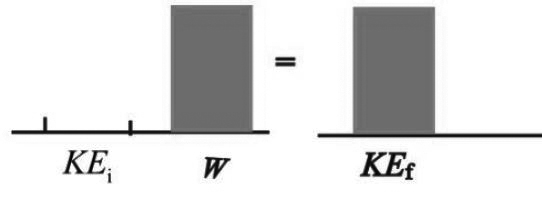
Concept explainers
(a)
To explain: the consequences in terms of work and energy.
To draw: a bar graph for this situation.
(a)
Explanation of Solution
Introduction:
Work done on an object is equal to the product of the force applied on the object
The expression for the work done is given by
The person uses an air hose to apply force on the puck and thus the force displaces the puck to a certain distance. So, from the definition of work done, work is said to be done on the puck. If the person applied a force
Work done on object is used to change the energy of the object. Initially, work is done on the puck to move it a certain distance and a because of the work done on the puck, it undergoes motion. Therefore, the puck possesses kinetic energy in the final state.
Final kinetic energy is
Initial kinetic energy is
Equation for work done on the puck is
Since the puck is initially at rest,
Equation (3) becomes,
The following is the energy bar graph of the puck on the frictional air table. Initial kinetic energy of the puck is zero. The work done on the puck is equal to final kinetic energy.

(b)
To describe: The manner kinetic energy and work done should differ from those in the first situation.
(b)
Explanation of Solution
Introduction:
Work done on an object is equal to the product of the force applied on the object
If the mass of the puck is reduced to half
The expression the work done
Work done on the puck of mass
Since the work done on the puck of mass
Conclusion:
Hence, the smaller mass puck moves with a velocity that is 1.41 times that of the velocity of the larger puck.
(c)
To describe: The situation in part a, and b in terms of impulse and momentum.
(c)
Explanation of Solution
Introduction:
Work done on an object is equal to the product of the force applied on the object
Momentum of an object is the product of its mass
Impulse is equal to the change in momentum,
Use equation (1) in equation (2)
The momentum of the puck of mass
The momentum of the puck of mass
Divide equation (4) by equation (5)
Substitute the value of
From the above equation, it is clear that the pucks of mass
The impulse on the puck of mass
The impulse on the puck of mass
Divide equation (7) by (8),
Substitute the value of
From the equation, it is clear that the pucks of mass
Conclusion:
Hence, it is described the situation of part a and b in terms of impulse and momentum.
Chapter 11 Solutions
Glencoe Physics: Principles and Problems, Student Edition
Additional Science Textbook Solutions
Physics for Scientists and Engineers: A Strategic Approach, Vol. 1 (Chs 1-21) (4th Edition)
University Physics with Modern Physics (14th Edition)
Conceptual Physics (12th Edition)
College Physics: A Strategic Approach (4th Edition)
Essential University Physics: Volume 2 (3rd Edition)
 College PhysicsPhysicsISBN:9781305952300Author:Raymond A. Serway, Chris VuillePublisher:Cengage Learning
College PhysicsPhysicsISBN:9781305952300Author:Raymond A. Serway, Chris VuillePublisher:Cengage Learning University Physics (14th Edition)PhysicsISBN:9780133969290Author:Hugh D. Young, Roger A. FreedmanPublisher:PEARSON
University Physics (14th Edition)PhysicsISBN:9780133969290Author:Hugh D. Young, Roger A. FreedmanPublisher:PEARSON Introduction To Quantum MechanicsPhysicsISBN:9781107189638Author:Griffiths, David J., Schroeter, Darrell F.Publisher:Cambridge University Press
Introduction To Quantum MechanicsPhysicsISBN:9781107189638Author:Griffiths, David J., Schroeter, Darrell F.Publisher:Cambridge University Press Physics for Scientists and EngineersPhysicsISBN:9781337553278Author:Raymond A. Serway, John W. JewettPublisher:Cengage Learning
Physics for Scientists and EngineersPhysicsISBN:9781337553278Author:Raymond A. Serway, John W. JewettPublisher:Cengage Learning Lecture- Tutorials for Introductory AstronomyPhysicsISBN:9780321820464Author:Edward E. Prather, Tim P. Slater, Jeff P. Adams, Gina BrissendenPublisher:Addison-Wesley
Lecture- Tutorials for Introductory AstronomyPhysicsISBN:9780321820464Author:Edward E. Prather, Tim P. Slater, Jeff P. Adams, Gina BrissendenPublisher:Addison-Wesley College Physics: A Strategic Approach (4th Editio...PhysicsISBN:9780134609034Author:Randall D. Knight (Professor Emeritus), Brian Jones, Stuart FieldPublisher:PEARSON
College Physics: A Strategic Approach (4th Editio...PhysicsISBN:9780134609034Author:Randall D. Knight (Professor Emeritus), Brian Jones, Stuart FieldPublisher:PEARSON





